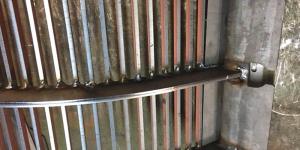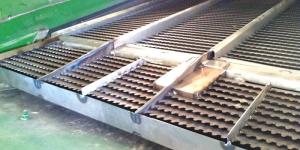2020 - Volume #44, Issue #4, Page #27
[ Sample Stories From This Issue | List of All Stories In This Issue | Print this story
| Read this issue]
He Sells Field-Tested Combine Upgrades
 |
 |
 |
“My brother and I were doing custom combining, and no matter what brand of combines we were running, I was never completely satisfied,” says West. “The price of these things is outrageous, and if you pay that much, you should get more from it.”
West admits that he didn’t do anything about his frustrations for a long time. At the advice of Mike Ellison, founder of Precision Ag Parts, that changed.
“I identified some areas that could be improved and suggested them to Mike,” recalls West. “He told me to try them myself, that I could do it.”
One of the first things he tried was to modify his OEM round bar concaves. He and his brother were harvesting 300-bushel per acre irrigated corn. They had to slow to a crawl to avoid rotor loss of the corn.
“I thought I would try 1/2-in. square bars, so I cut and ground out the round bars and replaced them,” says West. “They worked, and we picked up a mile an hour with less rotor loss. I was still not 100 percent satisfied, but we were getting more acres done per hour at the same cost per acre.”
The square bar concaves worked well enough that West started making and selling them through Precision Ag Parts. However, after 5 or 6 years, the square bars began showing wear. West rethought the problem.
“A concave is designed to thresh with the bars and separate with the spaces,” he says. “I discovered that if I went with 1/4-in. by 1/2-in. bars I could get 7 more bars and 7 more spaces into the same opening.”
West sent the Flat Bar Concaves to a friend in Nebraska to try. “He ran them for a week or two and told me they were like square bars on steroids,” recalls West.
West applied the same approach to other areas he felt could be improved. Most of them worked and either increased capacity, cut down fuel usage, or outlasted OEM parts.
A good example is the Fan Relocation Bracket (Vol. 41, No. 1). The simple swap makes the fan more efficient and effective, eliminating dead spots. The S Series Sieve Extension reduces the load on the return system by half, which lets the rethresher work as intended.
Some upgrades are simply more rugged, like replacing Deere’s 14-ga. STS/S Feeder House Seal with a 10-ga. seal that doubles the life of the original and prevents small grain seed loss. Likewise, West’s Hinged Feed Plate replaces the OEM feed plate with its hinge exposed to wear. The Harvest Solutions feed plate has a heavier hinge that is not a wear point and will last 2 to 3 times longer.
West fixed a problem on Deere 9600 through S Series combines. A lower seal on the clean grain gearbox was exposed to grain and dirt. His simple $55 seal stops foreign material from entering the gearbox. The 10-min. fix can prevent a $2,000 failure. Similarly the Elevator Drive Shear Hub replaces the OEM hub. Any number of things can cause the elevator drive belt to stop while the pulley keeps turning. With the OEM hub, this can result in expensive and time-consuming repairs. With West’s shear hub, it requires a 5-min. bolt replacement.
While West is no longer running combines, he is still coming up with solutions to problems with combines. It is a process he encourages other farmers to embrace.
“People need to stop and think about the problems they run into with equipment,” says West. “Then, like I was told, don’t be afraid to try something.”
Contact: FARM SHOW Followup, Harvest Solutions, Inc., 81297 Blue Bucket Ln., Hermiston, Ore. 97838 (ph 541 786-2358; harvestsolutionsinc@gmail.com; www.harvestsolutionsinc.com).

Click here to download page story appeared in.

Click here to read entire issue
To read the rest of this story, download this issue below or click here to register with your account number.




